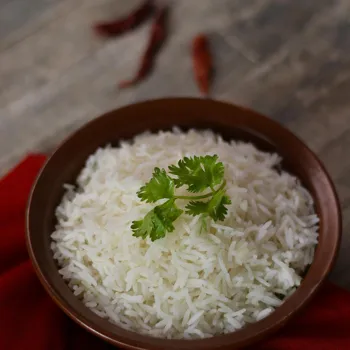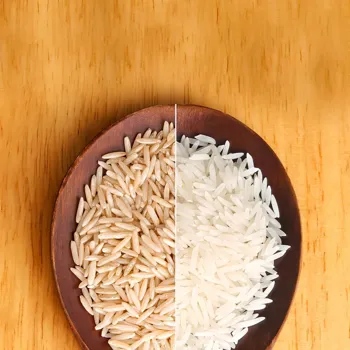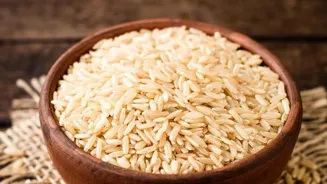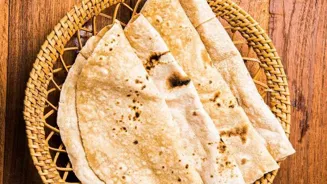Unveiling the Secrets of Perfect Basmati Rice: Master the Art and Science for Flawless Results Every Time!
For most Indian households, rice is more than just a staple; it’s an emotion. And when it comes
to rice, Basmati reigns supreme. Its delicate aroma, long grains, and fluffy texture make it the star of biryanis, pulaos, and even a simple dal-chawal meal.

But achieving that "perfect" Basmati– each grain separate, cooked just right, and bursting with fragrance – can sometimes feel like an elusive goal. Fear not, home cooks! We're here to demystify the science behind cooking perfect Basmati rice, every single time.
Forget the guessing game, and let's get down to the nitty-gritty of ratios, techniques, and little secrets that separate the good from the truly exceptional. You'll be serving up magazine-worthy rice in no time!
Mastering this skill isn't just about following a recipe; it's about understanding the process, allowing you to adapt and create consistently delightful results, and impress even the toughest critics – your family!
Select aged Basmati rice, wash, soak before cooking
The journey to perfect Basmati begins long before the rice hits the pot. Selection is key. Opt for aged Basmati rice, as it contains less moisture and is less likely to become sticky during cooking. Check the packaging for the origin and aging period; older is generally better.
Look for unbroken, long grains that are uniform in color. Once you've got your hands on quality rice, the next crucial step is washing. This isn't just about hygiene; it's about removing excess starch that can lead to clumping.
Gently rinse the rice under cold running water, swirling it with your fingers, until the water runs clear. This usually takes 3-4 rinses. Be careful not to be too rough, as excessive washing can break the grains. After washing, soaking the rice is a game-changer.
Soaking allows the grains to absorb water, reducing the cooking time and resulting in a more evenly cooked, fluffier outcome. Soak the rice in fresh, cold water for at least 30 minutes, and up to an hour. This step is especially important for older rice varieties.
Basmati rice cooking: water ratio, methods, and tips
Now, let's talk about the water ratio. This is where many cooks stumble. The ideal ratio for Basmati rice is generally 1:2 (1 cup of rice to 2 cups of water). However, this can vary slightly depending on the age and variety of the rice, as well as your cooking method.

A good starting point is to stick to the 1:2 ratio and adjust slightly based on your experience. If your rice is consistently coming out mushy, try reducing the water by a tablespoon or two. If it's too dry, add a little more water next time.
Cooking Basmati rice is not just about the ratio of water; the technique is equally crucial. Several methods yield excellent results, including the absorption method (where all the water is absorbed), the boiling method (where excess water is drained), and the pressure cooker method.
For the absorption method, bring the rice and water to a boil in a heavy-bottomed pot. Once boiling, reduce the heat to the lowest setting, cover tightly, and simmer for 15-20 minutes, or until all the water is absorbed.
Avoid lifting the lid during cooking, as this releases steam and affects the outcome. And whatever you do, don’t forget a little salt.
Cook rice perfectly: boil or pressure cook, rest after cooking
For those who prefer the boiling method, bring a large pot of water to a rolling boil. Add the rinsed and soaked rice, and cook for 8-10 minutes, or until the rice is almost cooked but still has a slight bite. Drain the rice in a fine-mesh sieve and return it to the pot.
Cover the pot with a clean kitchen towel or paper towels, then place the lid on top. This helps to absorb any excess moisture and prevent the rice from becoming soggy. Let it steam for 5-10 minutes before fluffing with a fork. The pressure cooker method is the quickest option.
Add the rice and water to the pressure cooker, seal the lid, and cook for one whistle on high heat. Then, reduce the heat to low and cook for another 5 minutes. Turn off the heat and allow the pressure to release naturally before opening the cooker.
Regardless of the cooking method you choose, the resting period is non-negotiable. Once the rice is cooked, let it rest, covered, for at least 10 minutes before fluffing it with a fork. This allows the steam to redistribute evenly, resulting in perfectly separated grains.
Enhance rice with fat, aromatics, broth for richer flavor
Adding a touch of fat to the rice can enhance its flavor and prevent sticking. A teaspoon of ghee or butter can make a significant difference. Simply melt the ghee or butter in the pot before adding the rice and water.
You can also add a few drops of lemon juice to the cooking water to help keep the grains separated and brighten the flavor. Another trick is to add a bay leaf or a small piece of cinnamon stick to the pot while cooking.
These aromatics infuse the rice with a subtle, fragrant flavor that elevates it to another level. Remember to remove the bay leaf or cinnamon stick before serving. For a richer flavor, try using vegetable broth instead of water to cook the rice. This adds depth and complexity to the dish.
If you're making a pulao, you can sauté some chopped onions, garlic, and ginger in ghee before adding the rice and water. This creates a flavorful base that will permeate the entire dish.
Cook rice in batches for even cooking, serve fresh, store leftovers 3 days, reheat gently
Don't overcrowd the pot. Cook rice in batches if necessary, to ensure even cooking. Too much rice in the pot will lower the temperature of the water and result in unevenly cooked rice. Serve the rice immediately after cooking for the best texture and flavor.
Leftover cooked rice can be stored in an airtight container in the refrigerator for up to 3 days. To reheat, add a tablespoon of water and microwave for a minute or two, or steam it over low heat. Avoid reheating rice multiple times, as this can affect its texture and flavor.
When cleaning the rice pot, soak it in warm, soapy water to loosen any stuck-on rice. Avoid using abrasive scrubbers, as they can damage the non-stick coating. Experiment with different types of Basmati rice to find your favorite.
Some varieties are more fragrant than others, while some have a more pronounced nutty flavor.
Practice patience and experimentation for perfect Basmati rice
Cooking perfect Basmati rice is a skill that improves with practice. Don't be discouraged if your first attempt isn't perfect. Keep experimenting with different techniques and ratios until you find what works best for you. The most important ingredient is patience and attention to detail.
Once you've mastered the basics, you can start experimenting with different flavors and variations. Try adding vegetables, herbs, or spices to create your own signature rice dishes.
With a little bit of science and a lot of love, you too can achieve the elusive goal of perfect Basmati rice, every single time. So go forth, embrace the rice, and enjoy the journey of culinary discovery!
And remember, sharing a meal of perfectly cooked Basmati rice with loved ones is one of life's simplest pleasures.
AI Generated Content. Glance/InMobi shall have no liability for the content








